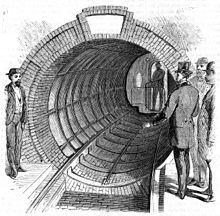Beach Pneumatic Transit
The Beach Pneumatic Transit was an experimental mode of transport. It was a 95 m long tunnel under Broadway , in which from 1870 to 1873 a car powered by compressed air ran, similar to a pneumatic tube . The namesake of the first (unsuccessful) attempt to build a subway in New York City was the inventor and publisher Alfred Ely Beach .
story
In order to relieve Broadway from the steadily increasing volume of traffic, Beach proposed the construction of a subway. In contrast to others, he preferred pneumatics as the type of drive, not steam locomotives , as they were successfully used on the Metropolitan Railway in London, which opened in 1863 . Beach was also interested in pneumatic tube systems for transporting letters and parcels. After receiving a concession from New York State , he began building an underground pneumatic tube in 1869.
During the construction work, Beach decided to set up a demonstration track for passenger transport instead. He managed to carry out his building project largely in secret. Although individual newspapers reported the delivery of large quantities of building materials to Warren Street, it was not until January 1870 that the public found out about the actual events in an article in the New York Tribune (probably commissioned by Beach himself) .
A few weeks later, on February 26, 1870, the Beach Pneumatic Transit opened. At the time, the tunnel was 312 feet (95 meters) long and led to Murray Street. The train itself was more of a curiosity than a serious means of transport. A single car shuttled from one end of the tunnel to the other and back again. The station was on the corner of Warren Street and Broadway in the basement of a clothing store.
Beach planned to extend the tunnel and develop it into a full-fledged subway, but this required a new concession. Senator William Tweed introduced a bill to this effect, but it was not passed. When, in late 1871, the political maneuvers of the corrupt lobby group, Tammany Hall, fell into disrepute, Beach claimed Tweed spoke out against his subway in order to gain the support of reformers. The real opposition, however, came from among the politically organized landowners along Broadway, led by Alexander Turney Stewart and John Jacob Astor III . They feared that the tunnel construction could damage the buildings and affect road traffic.
Laws to build Beach's subway were passed in 1871 and 1872, but were vetoed by Governor John Thompson Hoffman , as they left the state and the city too little influence. In 1873, Governor John Adams Dix signed a similar bill, but Beach could not raise enough money to finance construction for the next six months. A banking crisis that dried up the financial market made the realization unlikely.
Other investors had built an elevated railway on Greenwich Street and Ninth Avenue , which from 1870 onwards was operated successfully with small steam locomotives. The wealthy landowners had no objection to a train that ran off Broadway. In the mid-1870s, the public got the impression that Beach's compressed air train was impractical and technically too complex, despite the actually comfortable principle of locomotion. For the next 30 years, elevated railways dominated the action. The tunnel was forgotten until 1912 construction workers on the BMT Broadway Line broke through a wall leading to the station and found parts of the facility intact. The current City Hall station on lines N and R contains parts of the original Beach tunnel. A memorial plaque, which was reported in 1932 and which was intended to commemorate his achievement, no longer exists today.
Aftermath
Decades after its closure, the Beach Pneumatic Transit found its way into pop culture in a variety of ways. Some examples:
- The song Sub-Rosa Subway on the 1976 album 3:47 EST by the Canadian progressive rock band Klaatu is about Beach's efforts to build a subway.
- In the 1989 film Ghostbusters II, while searching for supernatural phenomena, the ghost hunters stumble upon the abandoned tunnel of the Beach Pneumatic Transit (referred to in the film as the New York Pneumatic Railroad ), where a stream of slime flows underground.
- The picture shown above adorns many branches of the Subway fast-food chain as a wall painting .
- The Beach Pneumatic Transit system appears in "Wormquake! - Part 1" of the 2012 Teenage Mutant Ninja Turtles series .
Web links
- Article by Joseph Brennan
- Detailed report on the facility with photos
- Article on nycsubway.org
- Sub-Rosa Subway lyrics
Coordinates: 40 ° 42 ′ 48 ″ N , 74 ° 0 ′ 25.2 ″ W.

